#like the fact that benny enjoys being Betty
Explore tagged Tumblr posts
Text
i absolutely love how offended Ethan gets when Rory says he isn't into Veronica
#that poor guy just wanted Rory to be into him#i love how literally every ship between the main five has like canon interactions that solidify it#like ethan and rory in die pod and three cheers for evil#die pod is my favourite episode for two reasons#bc its a rory episode and bc it's very ethory coded#rory was my favourite character growing up#the three cheers for evil episode so is good in so many ways#like the fact that benny enjoys being Betty#and the whole rory and benny plotline#the whole jealousy thing with ethan and rory#also as always serica kills in this episode#i decided to watch mbav while i studied but now im just making random hcs and stuff instead of studying
18 notes
·
View notes
Text
Danny x reader insert—The Bikeriders


summary; in which your perception about Danny begins to change.
warning(s); none just fluff
author's note: thanks for voting in my last poll! expect more fics to come!

The first punch was thrown about an hour after the picnic started.
Of course a little blood and a couple of loose teeth on the ground didn't bother you when you were watching the Vandals from a distance alongside their wives.
Unfortunately, you were a little too close for comfort this time when the first punch was thrown and Kathy, Gail, and Betty were nowhere in sight.
Scrambling from the wooden picnic table, you sidestepped two drunken bikers tussling with Johnny on the ground. The two assailants wore colors you didn't recognize.
"You dumb pieces of—"
A breeze of nicotine rushed past you, making you stumble. His slew of insults got lost in the sound of violent grunts that took place behind you.
You opened your mouth to tell Benny to watch it, but you quickly shut up, knowing that your words would get lost in the wind as he headed straight for Johnny's rescue.
You couldn't have been more grateful for leaving your secluded spot at the picnic table just in time for Benny to tackle one of the bikers on top of Johnny, and throw him onto the wooden surface. Thankfully, you turned your head just in time to hear Benny's knuckles crack against the man's nose.
"Y/N!"
You lifted your head upwards, narrowly missing Wahoo and Corky as they drunkenly ran past you to help Benny—who was most likely getting himself killed because of his recklessness. You shielded your eyes from the sun and sprinted towards the voice that called out your name.
By the time you reached the pickup truck, Danny had his hand extended towards you. You took it, and he carefully pulled you up onto the bed of the truck, sweat sprinkling his forehead. Once he was sure you caught your footing, he released your hand and you took a seat on the blanket that was sprawled beneath you.
"I didn't know you liked seeing 'em fight up close," Danny joked, readjusting the strap of his camera around his neck. He pointed the silver lens at the mob that was now forming around the area where you were once sitting.
"I don't," you said, eyes going to the side of his face and then to the commotion from afar. You brushed the dirt and loose pieces of grass from your palms before sitting on the side of your knees folded under you.
Although you didn't care much for any of those Vandals, you only stuck around because the Wives were the only friends you truly had. The only thing setting you apart from them was the fact that you weren't married to one of those brutes in a matching leather jacket. (You weren't married at all, to be frank.) But this fact didn't bother you. In fact, you had no intention of ever wanting to marry a Vandal for the sake of them either getting killed on their bike or cut by somebody's knife. You simply enjoyed their company because it was must better than being alone.
But your dislike for some of the Vandals didn't outweigh your distrust for Danny.
Perhaps it was his probing questions towards you and your friends, or that invasive rectangular box with a lens that hung around his neck. Regardless, you didn't trust him fully. Either that, or he intrigued you and you didn't want to admit it entirely to yourself.
"How come you're not out there helpin' them?" You asked in between the clicks of his camera. "Don't know how to fight?"
You knew the answer to this, but you just wanted to shake off the embarrassment of nearly getting in the middle of a breakout fight.
"I'm not much of a fighter," he said with a chuckle, a look of amusement passing over his features. "I prefer to be behind the camera instead of in front of it."
"Well, I prefer there not be a camera in the first place."
"Is that why you won't let me take a picture of you, Y/N?"
You turned to look at him, your cheeks getting warmer than the sun beating down on you both. He was looking straight ahead, seemingly satisfied with the pictures of sweaty, bloody men rolling around in the dirt. He grinned when he finally looked at you. "You're camera shy. Is that why you won't let me take your picture?"
"I'm not shy. I just don't like my picture taken, that's all," you said, defensively.
"Well, do you like taking the pictures?" He got off his knees and sat next to you, removing the camera from around his neck.
You shuffled, putting a bit of distance between you. "I've never tried." You shrugged carelessly, finding this conversation to be pointless and ridiculous.
"Maybe you'll like being behind the camera, then."
Before you could respond, Danny placed his camera in your lap. "You look through that little square there," he said, pointing to the back of the camera, "and make sure it aligns just right. Then you pull this lever back and press that button at the top to take the picture."
You looked down at the camera in your hands before looking at Danny with a lifted brow.
He chuckled softly. "Come on, try it." He took the strap of the camera and carefully draped it around your neck, his fingers lightly brushing the little hairs there. Quietly, he demonstrated on how to hold it up to your face and you reluctantly mimicked his movements. "Now, just find something interesting."
You took a breath and let your eyes sweep over the picnic. The fight had settled down and the boys were separating to their own corners. Some went to wrap their arms around their wives as if they had won the battle. The beers were flying left and right and the bikes were roaring in the distance. Perceptively, you panned the camera all the way around until you landed on the photographer himself. He was busy tinkering with his portable microphone.
At the sound of the click, he looked up as if surprised to be the subject of your aperture.
"How does it feel to be the one in front of the camera?" You grinned, playfully.
"Still nothing compared to being behind it," He smiled back before hopping off the bed of the truck. "But since you took my picture, you know what that means, right?"
He offered his hand to help you down. He slid off the truck with his ease and released his hand before smoothing out your shirt.
"What?" you asked, removing the camera from around your neck and handing it to him.
"That I get to take a picture of you" he insisted, kindly. "Just one, I promise. If that's okay."
You crossed your arms as if to mull it over before rolling your eyes. "Fine. Just one. But I don't know how to pose or anything."
"Just be you," he said, setting down his portable microphone. He put the camera around his neck and lifted it up to his face, waiting to take your picture.
You sighed and hoisted yourself on the tail-end of the bed of the truck. You crossed your legs and set your hands in your lap. Just as you were about to look directly at the camera, Betty had called your name from afar, waving you over. The camera clicked as you looked over Danny's shoulder as the group migrated to a small bonfire.
"Perfect," Danny said, looking down at his camera. He glanced behind him as the group formed before looking back at you. "You look great."
You hopped off the truck. "But I wasn't ready," you said with a slight laugh, knowing he had caught you off guard just as you had done him. "I wasn't even looking."
"The most beautiful pictures are the candid ones, Y/N." His smile lingered before he bent down and picked up his equipment. Slowly he turned to join the rest of the group surrounding a small fire.
It took you a moment as the butterflies in your stomach began to flutter about. The smile on your face stuck like glue and all of sudden you were unsure of what to do with your hands.
That Danny...he sure was somethin'.
#bikeriders x reader#the bikeriders#danny x reader#bikeriders fanfiction#bikeriders fic#mike faist x reader#mike faist#danny x reader insert#mike faist bikeriders#bikeriders mike faist#the bikeriders x reader#the bikeriders fanfiction
116 notes
·
View notes
Text
Final family post
Betty's Family
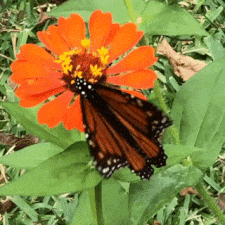
The Locera's are... Actually pretty wholesome. There's a brief mention of an unplanned child and sending said child to the other orphanage, but that has a happy ending.
Betty is the youngest runt of... 12 children in total. Six girls, six boys. Plus, two parents... Let's go over them all real quick.
Boris Locera: The first eldest, and most protective of all the Locera siblings. He and Betty are the closest since she was the runt, and he acted as a third caretaker for her (he was like that with the rest of their siblings, but Betty most especially). He moves to Inkwell with her to help her out.
Bonnie Locera: The second eldest. She deals more in selling and distribution rather than actually growing the flowers on the farm. She's firm, but has a good heart.
Billy Locera: The third eldest. He helps Bonnie with finances but is more relaxed than her.
Brittany Locera: The fourth eldest. She actually enjoys fashion and wants to start her own line of clothing. She still helps with the farm though.
Bryce Locera: The fifth eldest. He was actually the first who got married and started his own farm.
Beatrice Locera: The sixth eldest. She's the most social and was the most supportive of Betty moving out of Hayseed (not that the others weren't supportive).
Braydon Locera: The seventh eldest. He enjoys outdoorsy activities the most.
Barbara Locera: The eighth eldest. She is the most shy of them all, but will talk your ear off about animal facts if you let her.
Bryan Locera: The ninth eldest. He's the most quiet, but not in a shy way like Barbara. He wants to work at a library someday.
Blossom Locera: The tenth eldest. She, Betty, and Boris are the only single members of the family by far. But Blossom adores each of her neices and nephews.
Benny Locera: The second youngest. He's also close with Betty, but mostly because they both got babied.
Betty Locera: The youngest and most developed out of all the siblings. As mentioned before, she's the runt of them all so she's the smallest, and most fed up with being babied.
Bill Locera: A bit of a fretter, though will stand his ground if needed. He's a kind and caring father and husband and would do anything for his family. He was the one who taught the siblings how to be forgiving and understanding.
Bianca Locera: A tough woman who takes no-ones BS. She's more energetic than her husband, but she loves him all the same and adores all of her kids to bits. She was the one who taught them to speak their minds about anything and to have tough skin.
(Bonus fact: although I don't have pictures of them, Bianca has soft yellow coloring while Bill has a striking red coloring. All the Locera siblings are varying shades of orange)
Yeah. A big family. But they're all happy and love each other unconditionally. Betty and Boris live overseas in Inkwell now, but they do write to their siblings and parents often, and will visit during the holidays.
However, after seeing all the photos and hearing all the stories of her neices and nephews, Betty started wanting to have a child of her own (just one. Ain't no way in hell is she going to have a big nest like her parents if she can help it), but wasn't quite ready to date or get married. So, she made a visit to Inkwell Orphanage, and took in girl named Flower... who is a literal flower.
Flower belongs to @marshmallow-biscuit-blog (feel free to add onto this if you'd like ^^)
No one knew it just yet, but Flower actually still had a living parent... In fact, that parent just so happened to be one of Betty and Boris' new neighbors. A carnation by the name of Cagney.
Cagney, up to that point, had been a thorn in the butterflies' sides. Especially Betty's. She's not sure what exactly she did to annoy Cagney, but Betty has tried everything she knew to get him to cheer up. And she has long since reached her breaking point, and gives Cagney sass and attitude right back.
She and Boris were worried about how he'd treat Flower. But when the two flowers met, for once, Cagney was civil and... As nice as he can be. It was almost like he could tell that Flower was his child, despite technically never meeting her. And Flower actually looks up to the carnation.
I'm not sure how they'd all find out Flower and Cagney are related. But either way, Betty and Cagney managed to call a truce for Flower. As long as he doesn't try to hurt her kid, she'll welcome him in her garden.
(I'm debating it, but I'm thinking maybe Cagney and Betty start seeing each other. A rivals-to-lovers sort of thing. I'm greatly leaning towards it)
Any questions you guys have, I'll be more than happy to answer ^^
#my own characters#my own oc's#Betty Locera#other peoples characters#other peoples OC's#Cagney Carnation#TCS#Ci: DDwtD#The Cuphead Show#Cuphead in: Don't Deal with the Devil
8 notes
·
View notes
Text
Betty Carter
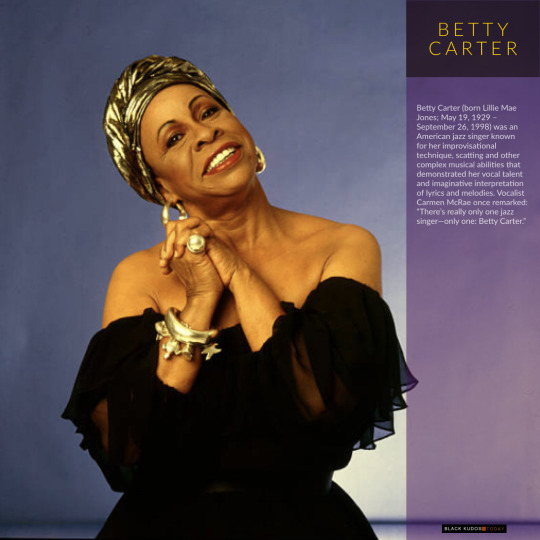
Betty Carter (born Lillie Mae Jones; May 19, 1929 – September 26, 1998) was an American jazz singer known for her improvisational technique, scatting and other complex musical abilities that demonstrated her vocal talent and imaginative interpretation of lyrics and melodies. Vocalist Carmen McRae once remarked: "There's really only one jazz singer—only one: Betty Carter."
Early life
Carter was born in Flint, Michigan, and grew up in Detroit, where her father, James Jones, was the musical director of a Detroit church and her mother, Bessie, was a housewife. As a child, Carter was raised to be extremely independent and to not expect nurturing from her family. Even 30 years after leaving home, Carter was still very aware of and affected by the home life she was raised in, and was quoted saying:
I have been far removed from my immediate family. There's been no real contact or phone calls home every week to find out how everybody is…As far as family is concerned, it's been a lonesome trek…It's probably just as much my fault as it is theirs, and I can't blame anybody for it. But there was…no real closeness, where the family urged me on, or said…'We're proud'…and all that. No, no…none of that happened.
While the lack of support from Carter's family caused her to feel isolated, it may also have instilled self-reliance and determination to succeed. She studied piano at the Detroit Conservatory at the age of 15, but only attained a modest level of expertise.
At the age of 16, Carter began singing. As her parents were not big proponents of her pursuing a singing career, she would sneak out at night to audition for amateur shows. After winning first place at her first amateur competition, Carter felt as though she were being accepted into the music world and decided that she must pursue it tirelessly. When she began performing live, she was too young to be admitted into bars, so she obtained a forged birth certificate to gain entry in order to perform.
Career
Even at a young age, Carter was able to bring a new vocal style to jazz. The breathiness of her voice was a characteristic seldom heard before her appearance on the music scene. She also was well known for her passion for scat singing and her strong belief that the throwaway attitude that most jazz musicians approached it with was inappropriate and wasteful due to its spontaneity and basic inventiveness, seldom seen elsewhere.
Detroit, where Carter grew up, was a hotbed of jazz growth. After signing with a talent agent after her win at amateur night, Carter had opportunities to perform with famous jazz artists such as Dizzy Gillespie, who visited Detroit for an extensive amount of time. Gillespie is often considered responsible for her strong passion for scatting. In earlier recordings, it is apparent that her scatting had similarities to the qualities of Gillespie's.
At the time of Gillespie's visit, Charlie Parker was receiving treatment in a psychiatric hospital, delaying her encounter with him. However, Carter eventually performed with Parker, as well as with his band consisting of Tommy Potter, Max Roach, and Miles Davis. After receiving praise from both Gillespie and Parker for her vocal prowess, Carter felt an upsurge in confidence and knew that she could make it in the business with perseverance.
Carter's confidence was well founded. In 1948, she was asked by Lionel Hampton to join his band. She finally had her big break. Working with Hampton's group gave her the chance to be bandmates with artists such as Charles Mingus and Wes Montgomery, as well as with Ernest Harold "Benny" Bailey, who had recently vacated Gillespie's band and Albert Thornton "Al" Grey who would later go on to join Gillespie's band. Hampton obviously had an ear for talent and a love for bebop. Carter too had a deep love for bebop as well as a talent for it. Hampton's wife Gladys gave her the nickname "Betty Bebop", a nickname she reportedly detested. Despite her good ear and charming personality, Carter was fiercely independent and had a tendency to attempt to resist Hampton's direction, while Hampton had a temper and was quick to anger. Hampton expected a lot from his players and did not want them to forget that he was the band's leader. She openly hated his swing style, refused to sing in a swinging way, and she was far too outspoken for his tastes. Carter honed her scat singing ability while on tour, which was not well received by Hampton as he did not enjoy her penchant for improvisation. Over the course of two and a half years, Hampton fired Carter a total of seven times.
Carter was part of the Lionel Hampton Orchestra that played at the famed Cavalcade of Jazz in Los Angeles at Wrigley Field which was produced by Leon Hefflin, Sr. on July 10, 1949. They did a second concert at Lane Field in San Diego on September 3, 1949. They also performed at the sixth famed Cavalcade of Jazz concert on June 25, 1950. Also featured on the same day were Roy Milton & His Solid Senders, Pee Wee Crayton's Orchestra, Dinah Washington, Tiny Davis & Her Hell Divers, and other artists. 16,000 people were reported to be in attendance and the concert ended early because of a fracas while Hampton's band played "Flying High".
Being a part of Hampton's band provided a few things for "The Kid" (a nickname bestowed upon Carter that stuck for the rest of her life): connections, and a new approach to music, making it so that all future musical attitudes that came from Carter bore the mark of Hampton's guidance. Because of Hampton's hiring of Carter, she also goes down in history as one of the last big band era jazz singers in history. However, by 1951, Carter left the band. After a short recuperation back home, Carter was in New York, working all over the city for the better part of the early 1950s, as well as participating in an extensive tour of the south, playing for "camp shows". This work made little to no money, but Carter believed it was necessary in order to develop as an artist, and was a way to "pay her dues".
Very soon after Carter's arrival in New York City, she was given the opportunity to record with King Pleasure and the Ray Bryant Trio, becoming more recognizable and well-known and subsequently being granted the chance to sing at the Apollo Theatre. This theatre was known for giving up-and-coming artists the final shove into becoming household names. Carter was propelled into prominence, recording with Epic label by 1955 and was a well-known artist by the late 1950s. Her first solo LP, Out There, was released on the Peacock label in 1958.
Miles Davis can be credited for Carter's bump in popularity, as he was the person who recommended to Ray Charles that he take Carter under his wing. Carter began touring with Charles in 1960, then making a recording of duets with him in 1961 (Ray Charles and Betty Carter), including the R&B-chart-topping "Baby, It's Cold Outside", which brought her a measure of popular recognition. In 1963 she toured in Japan with Sonny Rollins. She recorded for various labels during this period, including ABC-Paramount, Atco and United Artists, but was rarely satisfied with the resulting product. After three years of touring with Charles and a total of two recordings together, Carter took a hiatus from recording to marry. She and her husband had two children. However, she continued performing, not wanting to be dependent upon her husband for financial support.
The 1960s became an increasingly difficult time for Carter as she began to slip in fame, refusing to sing contemporary pop music, and her youth fading. Carter was nearly forty years old, which at the time was not conducive to a career in the public eye. Rock and roll, like pop, was steadily becoming more popular and provided cash flow for labels and recording companies. Carter had to work extremely hard to continue to book gigs because of the jazz decline. Her marriage also was beginning to crumble. By 1971, Carter was single and mainly performing live with a small group consisting of merely a piano, drums, and a bass. The Betty Carter trio was one of very few jazz groups to continue to book gigs in the late 1960s and early 1970s.
Carter created her own record label, Bet-Car Records, in 1969, the sole recording source of Carter's music for the next eighteen years:
....in fact, I think I was probably the first independent label out there in '69. People thought I was crazy when I did it. 'How are you gonna get any distribution?' I mean, 'How are you gonna take care of business and do that yourself?' 'Don't you need somebody else?' I said, 'Listen. Nobody was comin' this way and I wanted the records out there, so I found out that I could do it myself.' So, that's what I did. It's the best thing that ever happened to me. You know. We're talking about '69!
Some of her most famous recordings were originally issued on Bet-Car, including the double album The Audience with Betty Carter (1980). In 1980 she was the subject of a documentary film by Michelle Parkerson, But Then, She's Betty Carter. Carter's approach to music did not concern solely her method of recording and distribution, but also her choice in venues. Carter began performing at colleges and universities, starting in 1972 at Goddard College in Vermont. Carter was excited at this opportunity, as it was since the mid-1960s that Carter had been wanting to visit schools and provide some sort of education for students. She began lecturing along with her musical performances, informing students of the history of jazz and its roots.
By 1975, Carter's life and work prospects began to improve, and Carter was beginning to be able to pick her own jobs once again, touring in Europe, South America, and the United States. In 1976, Carter was a guest live performer on Saturday Night Live′s first season on the air, and was also a performer at the Newport Jazz Festival in 1977 and 1978, carving out a permanent place for herself in the music business as well as in the world of jazz.
In 1977, Carter enjoyed a new peak in critical and popular estimation, and taught a master class with her past mentor, Dizzy Gillespie, at Harvard. In the last decade of her life, Carter began to receive even wider acclaim and recognition. In 1987 she signed with Verve Records, who reissued most of her Bet-Car albums on CD for the first time and made them available to wider audiences. In 1988 she won a Grammy for her album Look What I Got! and sang in a guest appearance on The Cosby Show (episode "How Do You Get to Carnegie Hall?"). In 1994 she performed at the White House and was a headliner at Verve's 50th anniversary celebration in Carnegie Hall. She was the subject of a 1994 short film by Dick Fontaine, Betty Carter: New All the Time.
In 1997 she was awarded a National Medal of Arts by President Bill Clinton. This award was one of thousands, but Carter considered this medal to be her most important that she received in her lifetime.
Death
Carter continued to perform, tour, and record, as well as search for new talent until she was diagnosed with pancreatic cancer in the summer of 1998. She died on September 26, 1998, at the age of 69, and was later cremated. She was survived by her two sons.
Legacy
Carter often recruited young accompanists for performances and recordings, insisting that she "learned a lot from these young players, because they're raw and they come up with things that I would never think about doing."
1993 was Carter's biggest year of innovation, creating a program called Jazz Ahead, which took 20 students who were given the opportunity to spend an entire week training and composing with Carter, a program that still exists to this day and is hosted in The Kennedy Center.
Betty Carter is considered responsible for discovering great jazz talent, her discoveries including John Hicks, Curtis Lundy, Mulgrew Miller, Cyrus Chestnut, Dave Holland, Stephen Scott, Kenny Washington, Benny Green and more.
On June 25, 2019, The New York Times Magazine listed Betty Carter among hundreds of artists whose material was reportedly destroyed in the 2008 Universal fire.
Discography
CD compilations
1990: Compact Jazz – (Polygram) – Bet-Car and Verve recordings from 1976 to 1987
1992: I Can't Help It – (Impulse!/GRP) – the Out There and The Modern Sound albums on one compact disc
1999: Priceless Jazz – (GRP) – Peacock and ABC-Paramount recordings from 1958 and 1960
2003: Betty Carter's Finest Hour – (Verve) – recordings from 1958 to 1992
On multi-artist compilations
1988: "I'm Wishing" on Stay Awake: Various Interpretations of Music from Vintage Disney Films
1997: "Lonely House" on September Songs – The Music of Kurt Weill
10 notes
·
View notes
Note
*randomly knocks on your door and whispers* can you give me Top Cat hcs on the gang
I can iddly do! Thank you for asking!
To begin, this is a headcanon that @micaxiii and I talked about a long time ago... but I think the ultimate end game for the gang is for them to all move into Dibble’s apartment-- and for them to get jobs. I know, I know-- the horror! The shock! Yet, in Top Cat’s eyes, it gets WORSE! He’s going to end up working as a janitor at the district station Dibble works for, because of Dibble putting in a good word about him to get it. I know, I can hear what you’re saying, but it gets EVEN WORSE...
Top Cat is going to actually LIKE doing it.
I suppose I should explain. Pretty much the idea is that over time the gang will have character growth and realize just what all Dibble is doing for them. He offered them a home, he puts food in their bellies, he puts up with all their odd cat behavior. And somewhere, deep inside them, they’re touched. So it starts little. They help around they apartment, they cook and clean up after themselves. And little by little they cut down on their schemes-- until one day they realize they haven’t done a scheme at all in the past several weeks! What has become of them?!
I’m going to side step some, and talk about our other Feline Friends now:
Let’s talk about Brain. To start-- he’s actually really talented with numbers. And one day, after a long day of work, Officer Dibble comes home to see his kitchen table covered with organized piles of papers and Brain writing stuff down as the rest are doing different chores. Of course, old habits makes him suspicious as he asks what’s going on-- and Top Cat of course intervenes-- as he had already stopped everything he was doing as he greeted the man anyway. TC goes on to mention that they were cleaning out his closet, and saw a box of his receipts-- it looks like you’ve done nothing with it! Don’t you know tax season is upon us! Let me guess, you’re the type to put off filing your taxes to the last minute-- say no more, say no more. While we’ve never filed a single tax in our lives, just thought I’d set ol’ Brain up to it. Help keep him busy-- better than having him fumbling and breaking all the dishes.
But Dibble is just only looking on at Brain amazed-- seeing the book keeping and the expenses. “You... like doing this?” he asks Brain, genuinely curious. And Brain goes on to say he likes numbers-- and how TC used to have him keep track of everything. ‘Aint he just a peach?’ Top Cat butts in, a smug tone in his voice with a touch of genuine fondness. But it’s that day that sets a lot of things into motion-- as Dibble realizes that all of them have their own talents. And not only was Brain good at organizing it all, but he even made Dibble realize there was spots in his budget where he should be saving money.
This all leads to Brain being the first to get a job in the group, as Dibble talked his bosses into having him as their new accountant.
Moving on-- Benny. The running thing with him through the movies of the last few years seems to be ‘he cooks’. But let’s take out the joke that he’s BAD at it, and let’s make it more about ‘a cook is only as good as his ingredients’. And with fresh food, he ends up being able to make DELICIOUS meals. He starts small, making stews. But after a whole week of nothing but stews, the others start to complain. ‘Always stew this, and stew that! Can’t you make anything else?’ Thing is... he doesn’t know how. He’s never had the time or the resources to. And thus begins his time watching cooking shows, and when him hogging the tv ended up getting to be too much, Dibble getting him a Betty Crocker cook book. He flourishes.
It isn’t too long after that Dibble is asking one of the neighborhood restaurants if they might need an extra bit of help.
Oh good this is getting so long, I’m so sorry. Okay okay, gotta shoot these off faster. BULLET POINT TIME.
Choo-choo is good with kids. This is a canonical fact. I like the idea of him either using this time to help his sister out more with her kids, or maybe volunteering his time out to the local orphanage. They compensate him some, but honestly he’s just helping put because he likes feeling needed. It’s good for his depression.
Fancy ends up falling for a girl that ends up playing by his own book. He’s smitten, she’s wild-- she has opened up his world, baby! In the end she is surprised because she thought they were alike when it came to not being tied down, and while Fancy does feel hurt when she doesn’t ‘want to be his girl’-- they still remain friends and enjoys being with her. It does make him realize the importance of communication, and makes him realize he never wants a girl he’s with to feel heartbreak like he felt ever again.
Spooks and Fancy are cousins. Growing up their whole life thicker than thieves-- two peas in a pod. While Spooks is also inclined to flirt with dames here and there-- he has always made a point to take his Cuz aside and tell him one of these days his playing girls will bite him in the butt. SO he was especially happy to see him change his ways.
Spooks and Fancy both end up getting jobs as waiters at the restaurant Benny works at.
One day Top Cat will go to a Police Department Janitor summit and meet Penry-- aka Hong Kong Phooey. During the event something drastic will happen and Top Cat will be suspected of it because. And it will be up to Hong Kong Phooey, Officer Dibble, and the gang to clear him of the charges.
43 notes
·
View notes
Text
3/14/22 | Travel Thoughts..to Ireland!

It’s mid-March and I am running on 3 hours of sleep at London Heathrow.
Got a couple thoughts I want to jot down to document how I’m feeling at this time, realizations I have, and general updates on my life as 23-year-old Betty.
Firstly, the feelings of love I have are awfully strong, especially with my romantic love for my partner. It’s been a hard time getting to know Benny and understanding all his nuances, but for the good parts of our relationship, they have been splendid and sweet. I realize so much about him not only when I am with him, but even when we are apart.
On my flight to London today from New York, I learned that the reason it seems Benny is unendingly loving towards those he cares for is because he actively practices gratitude. Perhaps not in the way that I do - deep meditation, intense reflection on life, and existential crises - but in his own style. It’s almost like a constantly brewing gratitude in his heart for the people he selects to give all his energy to. I am honored to be one of those people.
Being in a relationship with Benneth has taught me some of the hardest lessons about other people, society, and myself. I am grateful to have learned so many of these things with him. There are no guarantees when it comes to love with other people and we will never know what the end will look like, only the moving forward and the present with one another. I love him very deeply and feel a love for him that I truly have never felt with anyone else.
Now that the mushiness is over, which I know a lot of people are probably not subscribed to as much as my deeper reflections and analyses of my life, we shall proceed into other realizations I’ve had. (VTN’s writing style is rubbing off on me. He’s improved my vocabulary significantly in 4 chapters! Tarmac?! Thank you!)
Getting on the plane from LAX to NY to London, I had a very clear game plan of what I was supposed to be doing. Spend the entire flight to NY reading and writing. Only read. Sleep the entire flight from NY to London. Read for a third and slept the rest of the way. Thus, I am running on a thin amount of sleep, if a little less, I’d be what Benny likes to call “grumpypants” and maybe a little more on the aggressive side.
Realization on the first flight: I have existed for almost 24 years on this planet. Twenty-four. I have existed for that long. I am soaking this in for when I read this at 30. I only have one more year until my brain is fully developed. Which means I have to do things until my brain gets done developing! I’m realizing that I am young and I should bathe in experiencing life, since that is all I have - experiences. Shout out to Amy for helping me come to this very important conclusion. I should go to museums since I like them so much and try out different foods! I should subscribe to a good, affordable gym since I enjoy being fit. There is an abundance of ways I can celebrate my life and develop my brain further. I should begin as soon as I can, now that I live in my own place and have begun my own life. In due time, I will have financial security, but with less regret down the road since I will have spent my time exploring Los Angeles and living my life freely!
Reading The Sympathizer also sucked me into a tornado of thoughts and reflection about my own Vietnamese history. I learned about the perspectives of both sides of the Vietnamese during the war and contemplated deeply about my relatives who have expressed their hatred for communists. I thought about how they took refuge in the United States, what ideas they believe in, and what makes them such strong nationalists, patriots, and advocates for capitalism.
I came to the conclusion that to simplify one human based on an ideology is dangerous. Even being in the London airport right now and seeing how racially diverse it is, is making me realize how similar every human is on the planet. To make a definite statement on a person based on a few facts about them is a bad judgment. One person has a full wealth of knowledge and experiences that I will never fully understand myself, even if they are different from mine. Especially if they are different from mine! I am still learning this today.
The book itself is riveting. The storyline has me stressed, but in all the best ways of understanding the pain and severity of this war to an entire nation. A nation that my family calls home. It helps me understand what my definition of being Vietnamese-American means, the first thought of this question starting in college and up to now with a recent film, After Yang, directed by Kogonada. My sister and I watched this masterpiece of a movie last week before we both departed to Europe. It also highlighted what it means to be Asian-American. That’s a question I am still posing to myself, because I do not have the clear answer. Yet. (Or maybe it's a fluid answer?) I hope to finish the book by the end of this month and also learn more about my family’s perspective about the Vietnam War. This is much needed for me, who would not have been born if this war had not occurred.
That’s a pretty hefty recap of my thoughts during my overseas transport. But, one more thing I’d like to wrap up with: I hope kindness is contagious. There is a chance that I misread the whole situation as I only came in during the ladder half, but a teenager was notifying a perhaps thirty-year-old woman that I would be switching seats with his friend. Immediately, it seemed she grew defensive about her seat and demanded she was not moving, even though that was not the request. He reassured her that she did not have to move, it was just the two seats next to her that were being changed.
In that moment, there seems to be a protectiveness that she had about her place and seat, when - like Lina says - it was not that serious. It seems many humans have a concern about their belongings and what they can claim is theirs, including seats and whatever is theirs that give personal benefit in any way. In this situation, I am certain her feelings were valid because she may have simply misunderstood the question and genuinely liked where she was seated. However, if we humans let the feeling of needing to claim what is ours and be protective over every part of our lives, maybe our world would look a little different.
The energy was very much every-man-for-himself vibes, which I personally do not like to engage in as a noncompetitive person outside of board games. If we share, express some understanding, and are patient with others, perhaps we would be happier and others may also feel more protected and cared for instead of alienated against. The full thought process is that hopefully kindness is contagious, so we can continue to be kind and generous in giving compassion and care for others. Would this not produce a better world?
0 notes
Text
Epic Movie (Re)Watch #235 - White Christmas
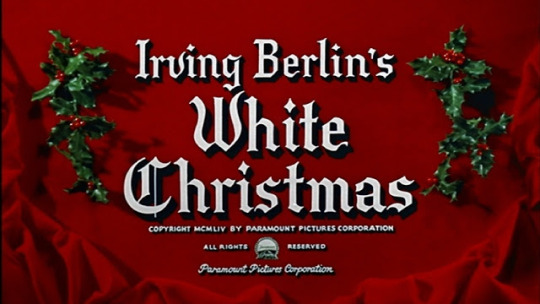
Spoilers Below
Have I seen it before: Yes
Did I like it then: Yes.
Do I remember it: Yes.
Did I see it in theaters: No.
Format: DVD
0) I know Christmas was a week ago but I’m just getting the chance to write this now so thanks for your patience everyone! :D
1) This was actually the THIRD film Bing Crosby sang “White Christmas” in after Holiday Inn and Blue Skies.

2) This film’s opening scene does well to establish the tone of the picture. It’s hopeful and sweet against a harsh backdrop, with showmen Bob Wallace and Phil Davis doing their best to bring some Christmas cheer to WW2 soldiers. It also establishes what kind of a man General Waverly is, which is important. The entire motivation for the film is helping this man out, this great men who all those soldiers care about so much. We understand why in this prologue.
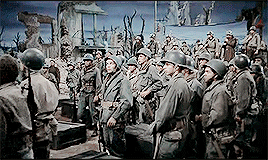
3) The first singing of “White Christmas” also does well to play up the movie’s heart. It gives a sense of the sentiment and kindness that permeates the two hour run time.

4) Danny Kaye as Phil Davis.

Kaye is the ultimate scene stealer of the entire show and was actually the third choice for the role. He is incredibly funny, bringing a much welcome energy and charisma to the part. He’s crafty (manipulating Bob in a harmless yet devious way), clever, and has a great chemistry with Bing Crosby’s Bob Wallace. Of the main four stars, Kaye is definitely my favorite.
5) Bing Crosby as Bob Wallace.
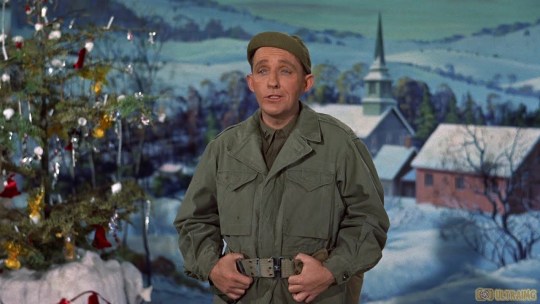
The straight man of Wallace & Davis, Crosby still gets to show off a nice sense of humor in the film. He gets the chance to be serious, fun, kind, a little sad, a little mad, romantic, and pulls all of them off well as the film’s solid lead. Obviously his vocal chops were a big part of the character, but he’s Bing Crosby. I don’t think there was ever a doubt he could sing.
6) The montage which follows the prologue does well to establish the post war rise of Wallace & Davis in showbiz. It’s an important aspect in the film which could have really slowed done the part but the montage is sleek and fun so as not to bore the audience.
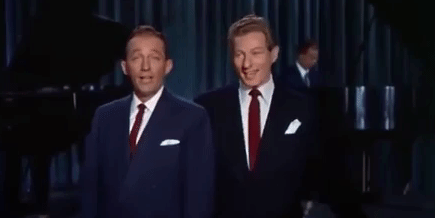
7) The conversation with Bob and Phil about how the latter wants the former to start dating so he can have some time alone really defines their relationship moving forward. We understand how good of friends they are that they can be candid but fun with each other. They joke, they tell it like it is, they play, and I just really like that.
8)
Betty: “Benny’s got a job in Alaska. He’s been out of the country for three months.”
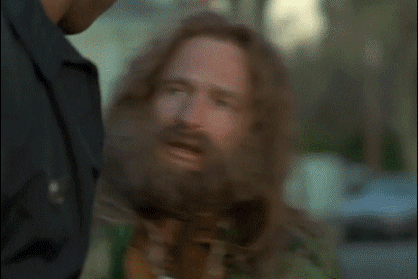
9) The relationship between Betty and Judy is wonderfully defined - not by their song - but by their conversation before the song. We understand how this relationship works much as the conversation with Bob & Phil established their friendship. We get how Judy sees Betty and vice versa and it’s great. A nice female friendship where there’s no bickering over a guy, a rare treat in the 1950s. Although I will say I never bought Vera-Ellen as being the younger sister here.
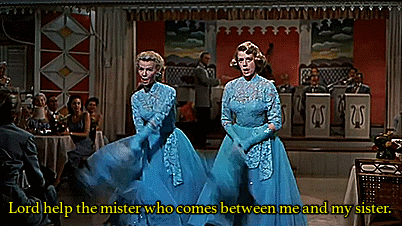
10) Rosemary Clooney as Betty.

Clooney is an extremely kind, likable, charismatic, and endearing performer who really elevates the role of Betty. She has a very nice chemistry with Crosby and is just so damn interesting. Which is good, because on paper Betty is freaking awful. I’ll talk about this more, but we get a sense of what’s to come with her holier-than-thou attitude when Bob begins talking about “angles”. Basically I love Rosemary Clooney in this movie, but I hate how Betty is written. It’s frustrating to say the least.
11) “The Best Things Happen While You’re Dancing”
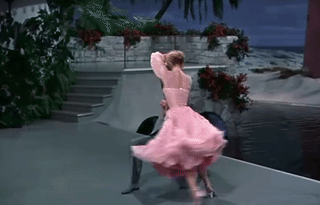
This early number shows off one of the film’s weakest and strongest elements simultaneously. Most if not all of the numbers do nothing to actually motivate the plot forward, instead just filling up the two hour run time. HOWEVER they’re almost all so damn entertaining it’s hard to actually find fault with this. You’re too busy enjoying the show!
12) According to IMDb:
According to Rosemary Clooney, Bing Crosby and Danny Kaye's "Sisters" performance was not originally in the script. They were clowning around on the set, and director Michael Curtiz thought it was so funny that he decided to film it. In the scene, Crosby's laughs are genuine and unscripted, as he was unable to hold a straight face due to Kaye's comedic dancing. Clooney said the filmmakers had a better take where Crosby didn't laugh, but when they ran them both, people liked the laughing version better.

13) Ah, the only person of color in the movie. And they’re servers.
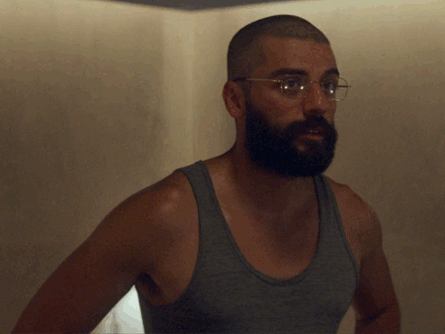
14) “Snow”
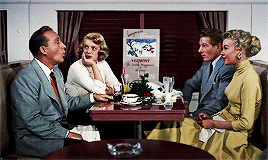
Snow is probably the second most Christmas-y song in the film after “White Christmas”. It shows off the four leads unity well (although Vera-Ellen didn’t do her own singing) and is one of my favorite numbers in the whole film. It’s charming and sweet, filled with winter charm and spirit. I dig it.
15) I like that the greenness of Vermont is a detail but not a focus of the film. Yes it’s called “White Christmas” and yes snow does bring in business to the hotel, but the conflict isn’t about trying to get it to snow it’s about trying to make an old friend happy for the holidays.
16) Dean Jagger General Waverly.
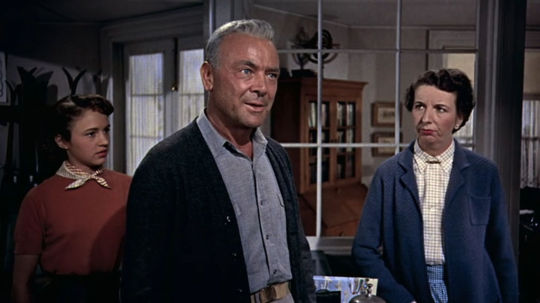
Waverly is the personification of the movie’s heart and sincerity, while also being my favorite character in the movie. You see how caring he is through subtle ways. He’s not one to express his emotions or his heart but you can see it clearly in Jagger’s performance. He is able to be commanding when necessary but more than that he is a kind, sometimes sad, honest man. I love it.
17) This was always one of my favorite gags in the film.
Bob [after hearing over the phone how much something will cost]: “Wow.”
Phil […]: “How much is wow?”
Bob: “Right in between in between, ‘ouch,’ and, ‘poing.’”
Phil: “Wow.”
18) The Minstrel Number.

This is one of the longest, most pointless numbers in the entire film. There is a great amount of entertainment and production value but it adds nothing to the story. While it is probably the strongest out of the three “performances” (the rehearsals Wallace & Davis are holding at the hotel), like the other two you can cut it and lose absolutely nothing from the film.
19) According to Rosemary Clooney, Bing Crosby improvised almost all of his dialogue in the scene where she meets him in the kitchen. You can tell and I mean that as a compliment. There is an honest spontaneity to the conversation which pulls you in because it’s so interesting.
20) “Count Your Blessings” is a wonderfully kind and moving number which has you invested in the romance between Bob/Betty quickly. Too bad the writing with Betty has me totally DISINTERESTED in them actually ending up together. But more on that later…
21) The scene where we learn that Waverly wanted back in the army but gets rejected not only develops him as a character (his motivations, his desires) but the heart of the film as well.
22) I mentioned that “The Minstrel Number” was one of three totally pointless numbers in the movie. “Choreography” is by far the worst offending of those three. It is not nearly entertaining enough to warrant its run time and serves as close to offending filler. Honestly just cut it.

23) Ah yes, what I’ve been hinting at this whole recap. The bane of my existence, the thing I hate in this movie above all else: freaking Betty becoming such a passive aggressive shit head! If you haven’t seen this movie let me recap:
Betty hears some BS about Bob out of context which paints him in a negative light
She takes this half-assed rumor as fact and immediately accepts it
She never ONCE actually talks to Bob about it
And then she just LEAVES! She runs away WITHOUT ACTUALLY SAYING WHY SHE’S UPSET!
BOB LITERALLY DOES NOTHING WRONG DURING THIS ENTIRE FILM, BETTY NEVER APOLOGIZES, AND BOB SPENDS THE REST OF THE MOVIE FEELING BAD OVER SOMETHING HE DIDN’T ACTUALLY DO!

It is infuriating and I hate Betty because of it. I hate her I hate her I hate her! BUT Rosemary Clooney is so damn charming I love her performance in the movie! But on paper alone Betty is being a passive aggressive shit who Bob devotes way too much energy into trying to appease her. IT’S NOT WORTH IT BOB! Of all the contrived pieces of bullshit in an attempt to add conflict in their relationship, this is the most painfully obvious piece of crap I have ever seen. I love this movie but dear god I freaking hate Betty in the last act.
24) I love that Judy basically cons Phil into an engagement with her and how freaked out he gets by it. Suddenly the dynamic of their relationship just shifted and it’s glorious.
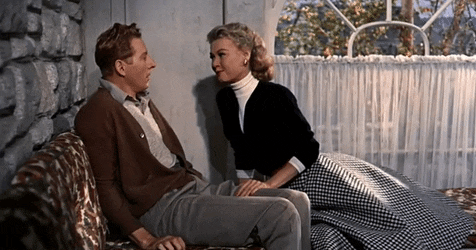
25) A fine piece of 50s BS sexist writing: suddenly Judy is a weeping hysterical woman because her plan didn’t go the way she thought. Which literally matches with NOTHING we learned about her before this moment.
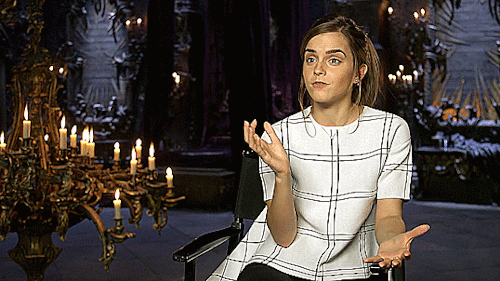
26) “Love You Didn’t Do Right By Me”

First of all, this is such a melodramatic and shitty move. “Love You Didn’t Do Right By Me?” SERIOUSLY!? Maybe it would’ve IF YOU TALKED TO BOB! I know that Betty asks to sing a different song when Bob shows up but clearly the filmmakers are trying something with this and I just, ugh, I HATE IT!
Second of all, the number is actually a great tune and a wonderful showcase for Rosemary Clooney’s talents. It’s her only solo in the entire film and she absolutely nails it. So again, a great example of how I love Clooney but I hate Betty in this film.
27) Phil keeping Waverly away from the TV set is an excellent showcase for Danny Kaye’s comedic talents. He may not be Charlie Chaplin but he’s damn good.
28) “What Can You Do with a General?”
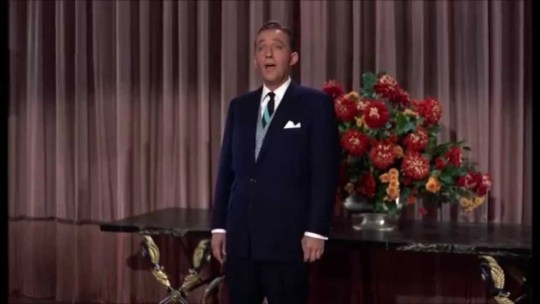
Leonard Maltin called this composer Irving Berlin’s least memorable tune. I disagree and in fact really enjoy it. It’s got a sense of cleverness to it. It’s sweet, a nice tune. A little slow but it gets stuck in your head. So in short: I disagree with Leonard Maltin.
29) The look on Waverly’s face is everything this film was about. EVERYTHING.
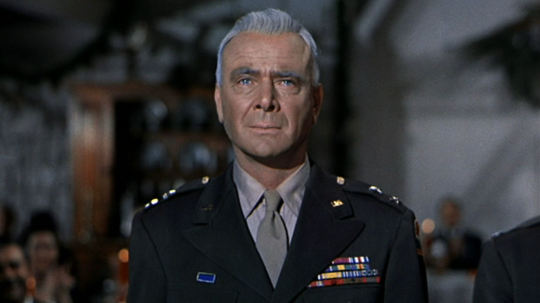
30) “Gee, I Wish I Was Back in the Army” is a fun and fitting near-climactic musical number for the film. It’s fun, funny, representative of the joy and humor that Wallace & Davis wanted to bring Waverly. Also, according to IMDb:
For the song "Gee, I Wish I Was Back In The Army", there is the lyric, "Jolson, Hope And Benny all for free". This is a reference to three wartime entertainers: Al Jolson, Bob Hopeand Jack Benny. The original words were "Crosby, Hope and Jolson all for free", but the lyric was changed because with Bing Crosby in the cast the original lyric would break the fourth wall.
31) While obvious from the film’s title, the snow fall at the end is a sweet way to wrap the story up. It’s not made into a big deal, they just enjoy it’s beauty. This leads into the final performance of “White Christmas” which acts as a poignant and fitting finale to the story.

White Christmas is a holiday classic with a great heart and sense of fun. The cast knock it out of the park and the music is great, and although I may have issues with some character writing (freaking Betty) I still love the film as a whole. I definitely recommend it.
#White Christmas#Bing Crosby#Rosemary Clooney#Danny Kaye#Vera Ellen#Epic Movie (Re)Watch#The More You Know#Movie#Film#GIF
19 notes
·
View notes
Text
Ethel Merman and the Boy Scout Show
S2;E19 ~ February 10, 1964


Synopsis
When Ethel Merman headlines the Annual Boy Scout Show, Lucy and Viv are relegated to being costumers. Feeling sorry for them, Merman agrees to share the spotlight.
Regular Cast
Lucille Ball (Lucy Carmichael), Vivian Vance (Vivian Bagley), Gale Gordon (Theodore J. Mooney), Ralph Hart (Sherman Bagley) and Jimmy Garrett (Jerry Carmichael)
Candy Moore (Chris Carmichael) does not appear in this episode.
Guest Cast

Ethel Merman was born in Queens, New York, in 1908. Known primarily for her powerful belt voice and roles in musical theatre, she has been called 'the undisputed First Lady of the musical comedy stage.' Among her many stage credits are: Anything Goes (1934), DuBarry Was a Lady (1939), Annie Get Your Gun (1946), Call Me Madam (1950), and Gypsy (1959). “There's No Business Like Show Business” from Annie Get Your Gun became her signature song. It was also the title of a 1954 movie musical starring Merman. Hollywood was not always friendly to Merman, who was replaced for the film versions of Annie Get Your Gun (1950) by Betty Hutton, Gypsy (1962) by Rosalind Russell, and Dubarry Was A Lady (1943) by Lucille Ball! Dubarry Was A Lady also included the song “Friendship,” which was featured in “Lucy and Ethel Buy the Same Dress” (ILL S3;E3). In 1934 Ball and Merman co-starred with Eddie Cantor in the film Kid Millions. Merman recreated her stage performances on TV in “Panama Hattie” (1954) and “Annie Get Your Gun” (1967). Merman died in 1984 from a long illness after a brain tumor.
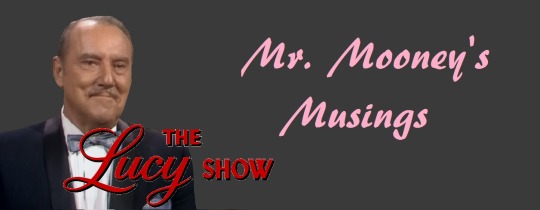
LUCY: “You’d think she was the biggest star on Broadway.” VIV: “She is.”

This was the second of two episodes to feature Ethel Merman. Originally, they were intended to be one episode, filmed on December 5, 1963, but the material seemed rushed and the stars were enjoying the work so it was decided to expand into a second episode. The first draft of this script was dated November 20, 1963 with pink and blue pages (updates and changes) from December 1963.
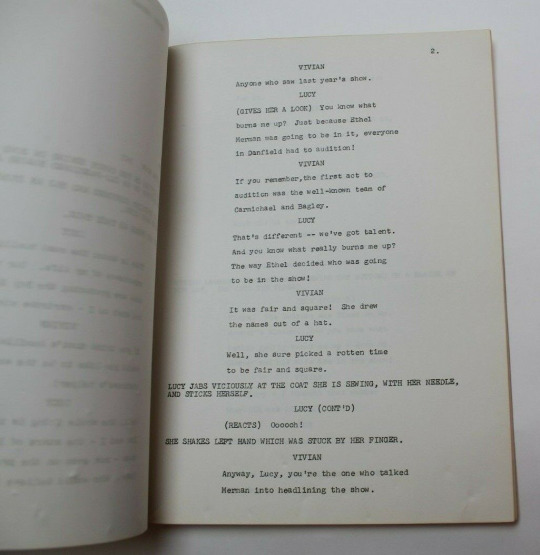
The previous episode (which originally had this episode's title) was re-titled “Lucy Teaches Ethel Merman To Sing” and the final scene of it was rewritten to lead into this one. However, due to Merman's schedule, it wasn't filmed until a month later. By that time, Lucy had started wearing a new wig, Viv was tanned from a Christmas vacation, and Merman had changed her hair color. In between the two episodes, Desilu produced “Lucy Plays Florence Nightingale” (S2;E14), “Lucy Goes To Art Class” (S2;E15) and “Chris Goes Steady” (S2;E16).
These two Ethel Merman episodes were re-run on CBS on May 24 and June 1, 1964.

Lucy was a big fan of Ethel Merman and offered her a guest spot after her Desilu pilot “Maggie Brown” was not picked up for series. Lucille Ball and Gary Morton attended the filming of the pilot and Merman also was in the audience for an episode of “The Lucy Show.” On the DVD extras, Jimmy Garrett recalls that Lucille Ball caught him watching filming from the wings and whispered "Watch very carefully. You'll never see anyone better."

Vivian Vance understudied Ethel Merman as Reno Sweeney in the 1934 Broadway musicals Anything Goes and Red, Hot and Blue (1936), both by Cole Porter.
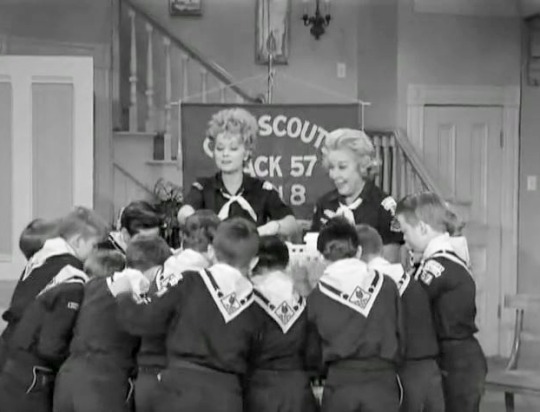
Merman is living with Lucy and Viv while she's in Danfield. Lucy and Viv were established as den mothers of their sons' scout troupe in “Lucy Visits the White House” (S1;E25).
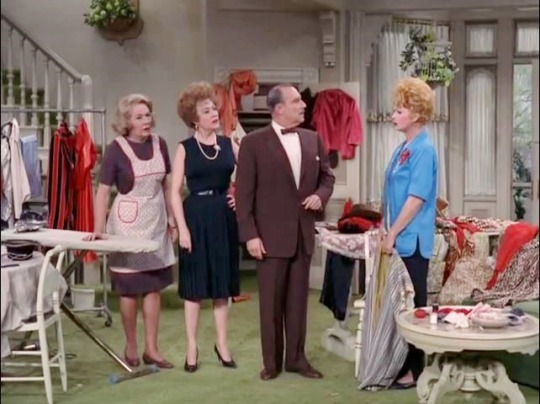
Mr. Mooney's daughter Rosemary, who lives in Trenton, New Jersey, is about to give birth to his first grandchild. This is the fourth Mooney child to be mentioned on the series: Arnold, Bob, Ted Jr. and Rosemary. Like her mother, Irma, Rosemary is never actually seen. Lucille Ball briefly lived in Trenton, New Jersey, as an infant.
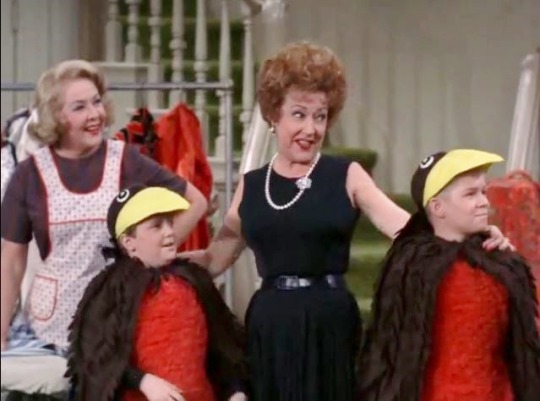
In the living room, Merman sings a few bars of “Red, Red Robin” with Jerry and Sherman dancing around her in bird costumes. "When the Red, Red Robin (Comes Bob, Bob, Bobbin' Along)" was a 1926 popular song written by Harry Woods. It was a big hit for Al Joleson, Bing Crosby, and Doris Day.
When Viv demands Lucy finish her costume right away, Lucy calls her a “wicked stepsister” - a reference to the fairy tale “Cinderella.” The line gets a large round of applause from the studio audience.

Lucy says the old manual sewing machine belongs in the Betsy Ross museum.
LUCY: “When I looked at the bobbin it was full of red, white, and blue thread.”
Coincidentally, as Lucy says this, she is wearing a blue shirt, with red and white tape measures around her neck.

Elizabeth ‘Betsy’ Griscom Ross (1752–1836) is widely credited with making the first American flag. Although there is no actual Betsy Ross museum, the Betsy Ross House on Arch Street in Philadelphia is the location where she supposedly sewed the first flag, although this fact (and her residence there) is disputed by many historians. Betsy Ross was a character on “The Jack Benny Program” in 1964 (above) when Lucy played Mrs. Paul Revere!

Lucy tearfully tells Merman she’s always dreamed of having her ‘name up in lights’. She tediously spells out her full name: “L-U-C-I-L-L-E C-A-R-M-I-C-H-A-E-L”. Ethel replies “If you ever get to Broadway, you’ve got to get a shorter name!” Not coincidentally, Ethel Merman herself shortened her name for the marquee: she was born Ethel Agnes Zimmermann!
THE ANNUAL BOY SCOUT SHOW

Sherman does an acrobatic dance routine as an opening act
In “Lucy the Music Lover” (S1;E8), Sherman did a quick ballet dance through the living room to impress Lucy's date. Ralph Hart was also a musical theatre performer, seen in the film musicals Gypsy, The Music Man, and Bye Bye Birdie.
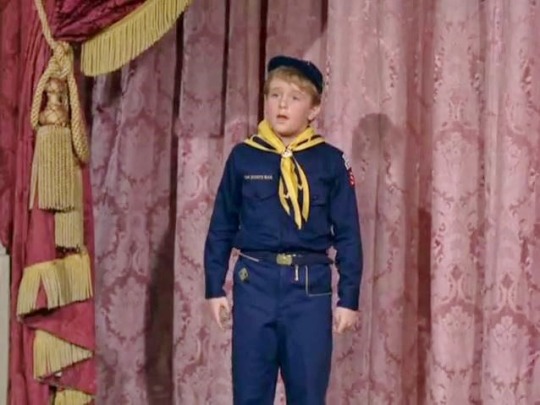
Jerry (in his scout uniform), tells a joke.
From his first audition for the series, Lucille Ball thought that Jimmy Garrett's dry delivery of his lines was hysterical.
The adult performers alternate in providing linking narration and paging the stage curtain to transition to the next act. Technically, the Boy Scout Show does not run in one continuous cut. The paging of the curtain allows for subtle edits in the film to piece together what were separate takes.

Merman, Lucy, Viv and Mr. Mooney sing “There's No Business Like Show Business”
The song is from Irving Berlin’s Annie Get Your Gun (1949). It will also be sung again the the Boy Scout Show's finale. Jerry spoke the title in the previous episode “Lucy Teaches Ethel Merman To Sing” (S2;E18).
VAUDEVILLE
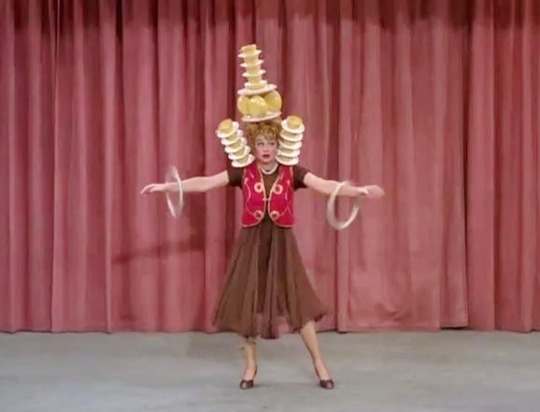
Lucy does a quick juggling act.
The plates are obviously rigged for comic effect.

Mr. Mooney and Viv sing "Tiptoe Through the Tulips", which was originally to be sung by Mr. Mooney and his wife Irma, had she not had to go to Trenton for the birth of their grandchild.
“Tiptoe Through the Tulips (with Me)” was composed by Joe Burke with lyrics by Al Dubin for the 1929 film Gold Diggers of Broadway. In 1968, it was sung by Tiny Tim, whose version charted at #17, becoming his signature song. Due to its resurgence in popularity, the title was also mentioned on several episodes of “Here’s Lucy”.
THE FLICKERS (aka SILENT MOVIES)

Lucy, Mr. Mooney, and Ethel Merman perform a silent movie sketch about a husband leaving his wife for another woman.
The sketch is pantomimed to honky-tonk piano accompaniment.
THE TALKIES

Viv as Shirley Temple sings "On the Good Ship Lollipop". Vivian Vance, an accomplished singer, makes a concerted effort to satirize the mannerisms and vocal limitations of a child performer like Shirley Temple.
"On the Good Ship Lollipop" was composed by Richard A. Whiting with lyrics by Sidney Clare. It was the signature song of child actress Shirley Temple, who first sang it in the 1934 movie Bright Eyes. Shirley Temple was mentioned on “I Love Lucy” in 1955's “The Tour” (ILL S4;E30), by which time the former child star was married and known as Shirley Temple Black.
BROADWAY MUSICALS
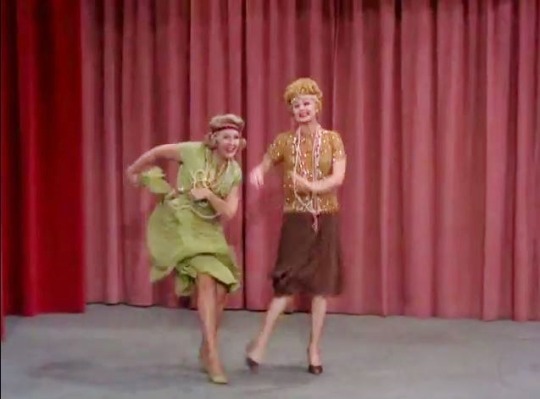
A tribute to 1920s stage musicals features Lucy, Viv, Ethel Merman and Mr. Mooney
In “Lucy Teaches Ethel Merman How To Sing” (S2;E18), Viv suggested dancing the Charleston for the Boy Scout Show, but the idea was shot down by producer Sherman. The sketch also features Gale Gordon doing a cartwheel, something he would do in future ‘show-within-a-show’ episodes. After being jilted, Lucy sings a few bars of “Am I Blue?” a song written by Harry Akst and Grant Clarke in 1929. It has since become a standard, covered by many musical artists. The sketch ends happily with Merman singing the final notes of her hit “I Got Rhythm”, a song she originated in the 1930 Gershwin musical Girl Crazy and also sang in the previous episode.
RADIO

Mr. Mooney is a radio host presenting a lady saxophone player (Lucy) from Altoona, Pennsylvania, playing "Glow Worm" (badly)
"The Glow-Worm" is a song from Paul Lincke's 1902 operetta Lysistrata. It was also used in the 1907 Broadway musical The Girl Behind The Counter. Lucille Ball had briefly played the saxophone as a child. During the radio sequence Mr. Mooney says “Round and round she goes! Where she stops, nobody knows!” This was a quote from “Ted Mack's Amateur Hour” a radio and TV talent show that began in 1934. A wheel of fortune was spun to determine the order of the performers and while it was spinning, Mack intoned the now-famous line. The show officially ended in 1970 but was revived briefly in 1993. Before entering television, Gale Gordon was the highest paid radio performer in Hollywood. Lucille Ball was also a radio performer with her own series “My Favorite Husband.”
TELEVISION

A tribute to “The Ed Sullivan Show” and its showcase of variety acts
To show the cyclic nature of entertainment, Lucy repeats the same exact juggling act she did at the start of the show. Ed Sullivan hosted an immensely popular variety show on CBS from 1948 to 1971. Up until 1955 it was called “Toast of the Town.” Ethel Merman frequently appeared on “The Ed Sullivan Show,” often singing her signature songs.
FINALE
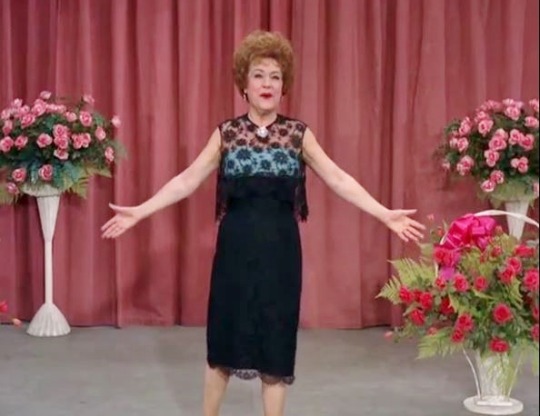
Ethel Merman sings "Everything's Coming Up Roses"
"Everything's Coming Up Roses" is a song introduced by Merman in the 1959 Broadway musical Gypsy with music by Jule Styne and lyrics by Stephen Sondheim. Merman sang the song throughout her career, even to a disco beat!

Everyone joins in for a reprise of “There’s No Business Like Show Business”
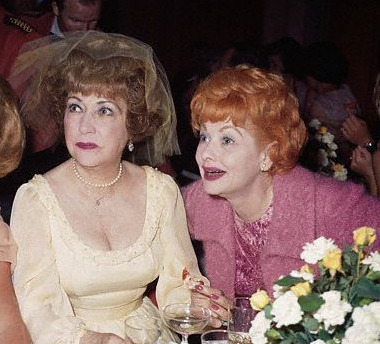
After the filming was complete, Merman recalled that she and Vance went to Lucille Ball's house for some girl talk and Lucille styled their hair – to disastrous results. Ball also threw Merman a bridal shower (above) before her month-long marriage to Ernest Borgnine in 1964.
Callbacks!

Lucy Ricardo used a sewing machine for the first time in “Lucy Wants New Furniture” (ILL S2;E28).

Cheesy vaudeville gags such Lucy’s rigged plate juggling were an integral part of the finale of “Ethel's Home Town” (ILL S4;E15). Fred and Ethel Mertz were former vaudevillians.
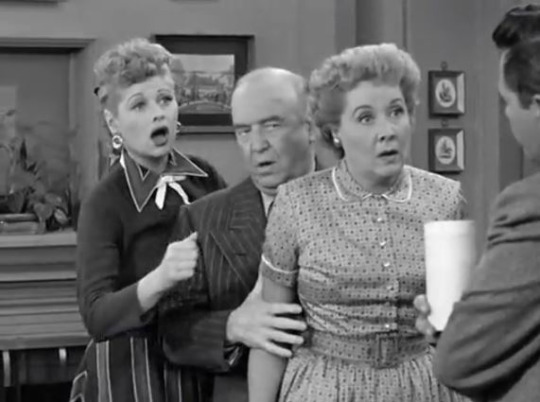
In “Lucy Has Her Eyes Examined” (ILL S3;E11), Lucy Ricardo and the Mertzes burst into an a capella rendition of “There’s No Business Like Show Business” in an impromptu audition for Mr. Parker, a Broadway producer. The song would also be quoted (not sung) by Lucy Ricardo in “Baby Pictures” (ILL S3;E5).
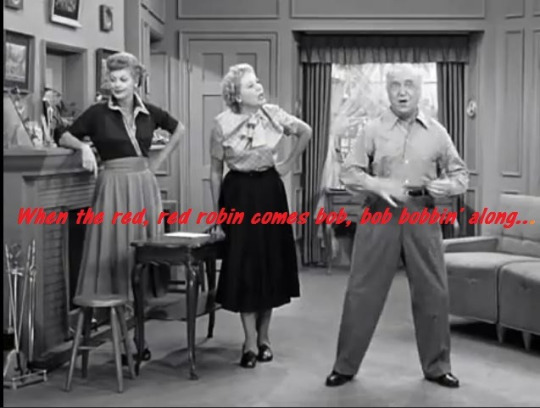
"When the Red, Red Robin (Comes Bob, Bob, Bobbin' Along)" was sung by Fred Mertz (William Frawley) in “Lucy and Ethel Buy the Same Dress” (ILL S3;E3) and later by Lucy Carter in “Guess Who Owes Lucy $23.50″ (HL S1;E11).
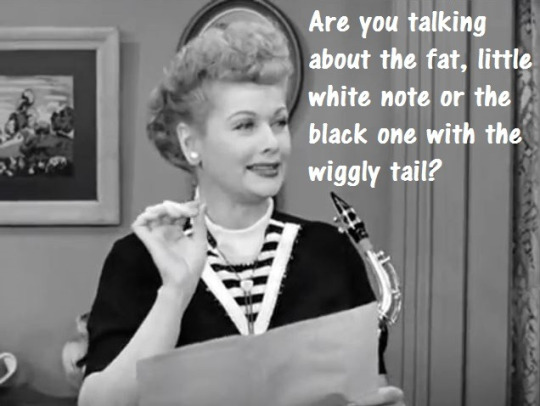
Lucy also played “Glow Worm” on “The Saxophone” (ILL S2;E2) and in “Lucy’s Club Dance” (ILL S3;E25). It was the only song she knew, until it was inexplicably “Sweet Sue” during season six!

LUCY: “Well, you see, Ethel. All my life I’ve wanted to be in show business!”
Lucy sobs in front of Ethel Merman because all her life she wanted to be in the show, something Lucy Ricardo also did many times on “I Love Lucy.” The above line might easily have been spoken to Ethel Mertz or Ricky, instead of Merman.

When Merman agrees to give up one of her numbers for Lucy to be in the show, Viv asks Lucy if she would really let a big star like Merman do such a thing. Lucy lets out a high-pitched “Weeeelll” the same way that Lucy Ricardo often did.

In 1954, “The Ed Sullivan Show” (aka “Toast of the Town”) devoted an entire hour to Lucy and Desi. Sullivan’s name and his show were mentioned several times on “I Love Lucy.”
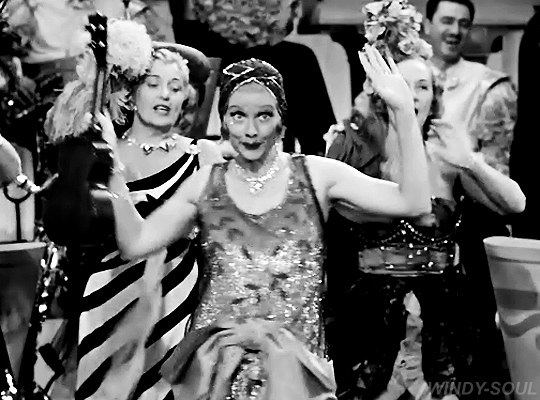
Lucy and Viv Charleston at the start of the ‘Broadway Musicals’ section of the Boy Scout Show. On “I Love Lucy” Lucy, Ricky, Fred and Ethel Charleston at the end of “Lucy Has Her Eyes Examined” (ILL S3;E11).

This is the second time a silent film skit has been part of “The Lucy Show.” The first was with Lucy as Charlie Chaplin during “Chris's New Year's Eve Party” (S1;E14).
Fast Forward!

Those red, red robins just keep bob, bob, bobbin’ again in “Kim Moves Out” (HL S4;E20) in 1974.
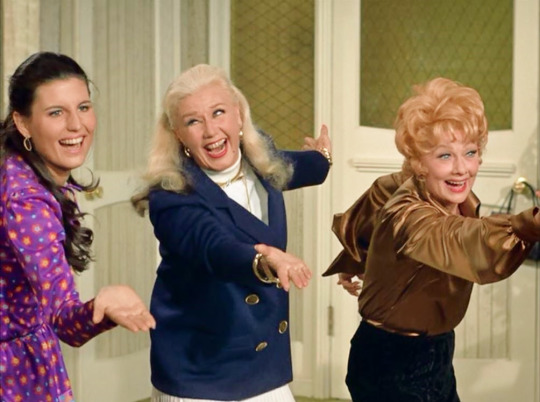
The Charleston never goes out of style, as demonstrated by Lucy and Kim Carter when “Ginger Rogers Comes to Tea” (HL S4;E11) on “Here’s Lucy” in 1971.
Blooper Alerts!

Flown the Coop! Although, Ethel Merman has Lucy make 24 robin costumes so that she can sing “When the Red, Red Robin” while the scouts dance around her, the song is not in the finished show!

Bulldog Cement? After the 1920's stage musical segment, Mr. Mooney's false mustache is falling off. It may have been due to spirit gum not adhering to Gale Gordon's own mustache or it may have been done for comic effect.

“Ethel Merman and the Boy Scout Show” rates 5 Paper Hearts out of 5

#Ethel Merman and the Boy Scout Show#The Lucy Show#Lucille Ball#Vivian Vance#Gale Gordon#Ethel Merman#TV#CBS#1964#Jimmy Garrett#Ralph Hart#show business#vaudeville#The Ed Sullivan Show#Shirley Temple#On the Good Ship Lollipop#Tiptoe Through the Tulips#cub scouts#Boy Scouts#silent movies#juggling#Glow Worm#Saxophone#Ted Mack Amateur Hour#Radio#There's No Business Like Show Business#Everything's Coming Up Roses#Am I Blue#Charleston#Roaring 20s
3 notes
·
View notes
Text
8 reasons to love Christchurch, New Zealand
Lieselot De Brauwer is a freelance writer and travel blogger. She sees herself as a world citizen, but lost her heart to New Zealand and was an expat in Christchurch. She specializes in New Zealand and Canada travel, outdoor adventures and inspiring others to explore new places on her blog The World is a Circus
So you’re finally planning to book your dream trip to New Zealand. Yay! About time, right?
But where to start? Flights I guess. Well, most people come in one of two ways. They fly into Auckland, which is New Zealand’s biggest city on the North Island, or into Christchurch, the biggest city on the South Island, which has my favorite airport in New Zealand.
Depending on how you plan your trip, you must visit Christchurch, an awesome place to start, finish or just plain visit all on its own.
A city in a land that is famous for its wilderness, it could be easy to overlook, but let me tell you, as an expat there for years, it’s worth stopping through to get a real for what makes New Zealand tick and to get a taste for real kiwi culture.
I’ll be honest. Christchurch and I weren’t love at first sight. It was more one of those slow and steady relationships where you really had to get to know each other first, with butterflies coming on later. But man, now I’m in love!
And that’s a similar story for a lot of expats. The local community is tight-knit and takes dedication and time to break into.
Back in 2014, I arrived to visit Christchurch on a Working Holiday Visa – it’s a very easy way to move to New Zealand for a year or two as a foreigner and travel around and work at the same time. It’s one of the best ways to get to know a place, and there’s a lot of work available in Christchurch.
Everything you need to know about moving to New Zealand on a working holiday visa
The story of Christchurch is one of both sadness and hope.
In 2010 and 2011 two big earthquakes hit Christchurch, killing 185 people and leaving the city in ruins. Seven years later and the city is still being rebuilt and has a very unique feel to it. It’s a place unlike any other I’ve been to. Empty parking lots now take up the space where buildings used to stand tall. The whole city feels like it’s still under construction, because, well, it still it.
But I highly recommend visitors look beyond the orange traffic cones and scaffolding because Christchurch has quickly become a vibrant and creative city. While many people left after the earthquakes to start there lives somewhere else, the people that stayed are incredibly passionate about growing the city in a creative and lovable way.
And because it’s changing all the time as the construction continues, it’s like a new city every month.
There are always temporary art pop up stalls around town, speakeasy bars and food trucks galore. The city is always visibly changing as it undergoes its rebuild.
New restaurants and unique bars keep popping up; there are little markets everywhere, cute cinemas and original stores that are so worth exploring! In one word, Christchurch is quirky, filled with hidden gems and little pop ups everywhere. There are even dancefloors outside with music in some of the places where buildings used to be where you can pop in some coins and dance like no one is watching to your favorite songs (spoiler alert – people are in fact always watching)
Here are some of my favorite reasons to visit Christchurch, New Zealand, and eight ways this city bit by bit made me fall in love with it. I can promise that you’ll fall in love with Christchurch too!
1. Christchurch has a kickass coffee culture
Seriously, you have to make an effort to have a bad cup of coffee in Christchurch, which would be a real shame!
New Zealanders are really into their coffee, especially the perfect flat white. I went from not drinking coffee to becoming a caffeine addict since moving here. Just saying… Be careful if you don’t want to get hooked on coffee.
Christchurch has an abundance of cafes, offering a lot of fresh meals and delicious drinks, many in quirky and unique spaces. It’s a real treat for your taste buds. Even you’re not into coffee they are great places to just hang out and spend some time while in the city.
I spend a lot of time in Addington Coffee Co-op. The food and coffee are delicious and they focus on an ethical way of doing business. 70% of their profit goes to local and overseas communities.
Another favorite is C1, downtown Christchurch. They literally have the food coming out of the ceiling – check it out for yourself if you don’t believe me! This is a Christchurch classic and local fave, and if you only go to one cafe, come here.
For brunch Hello Sunday is the place to be – tucked away in an old 19th century post office in Sydenham, make sure to book a table, as it’s very popular. Don’t be put off by the small and busy area when you enter, there is a larger room and courtyard in the back. Hello Sunday offers granola, quinoa salad, savory crumpets, the traditional eggs benny and so much more along with fabulous coffee. It’s really next level brunch, and therefore my favorite!
There are so many other cafes I love in Christchurch but here are a few:
Black Betty Cafe
The Cup Cafe
Park Ranger
Unknown Chapter
Uncommon
Supreme Supreme
Black and White Coffee Cartel
2. Admire all the amazing street art
Is it just me or do the best cities in the world have beautifully commissioned street art?
Christchurch breathes creativity. You just can’t escape it here.
The town has taken the rebuild after the quakes as an opportunity to make the city even better than it was before. The city center was a mess, but beyond the abandoned skyscrapers, walls of beauty started to appear. Local and international artists created street art throughout the city and helped bringing it back to life, many of which was on condemned buildings or the ruins of a place.
Now the trend is growing with huge beautiful murals popping up all the time, some of which are done by worldwide famous street artists, especially after the festival Rise in 2014, which brought in mega talent for an exhibit at the Canterbury Museum.
A walk through town will guide you past impressive street art. This interactive map shows you where to find the latest street art in town. Christchurch is actually called the Garden City, because of all its flowers and gardens, but I think we should call it the street art city. Don’t you agree?
3. And oh my god, the food!
After the Christchurch earthquakes, a wave of creative entrepreneurs started up their own hospitality businesses, making the city even more delicious, which means there is no shortage of incredible dining options around town.
And there is something for everyone. From oriental and Mexican to local lamb chops, here are a few of my favorite spots you definitely need to check out on any trip to Christchurch:
Pot Sticker Dumpling Bar. Warning: the food is to-die-for, and that’s probably what you’ll want to do after stuffing yourself with their dumplings and bao burgers. But don’t be scared, you’ll be in dumpling heaven!
Cook ‘N With Gas is more of a fine dining restaurant. It’s set in a historic 1860’s villa, with frames of old movie stars on the walls. They only use local vegetables and meat from the Island, and for a meal à la carte you’ll pay about 45NZD. It’s a bit more expensive than fish and chips, but I promise you won’t regret it.
Burgers & Beers is my favorite stop after a day out in the mountains. The staff is super friendly and the burgers are just as they should be: big, tasty and with lots of options (I always take the one with avocado!). Definitely the best burger joint in Christchurch.
The Afghan is a Christchurch secret and has all the goodness. It’s very basic, but the food is delicious and perfect to share with a group of friends.
Mythos Greek Souvlakis on Colombo Street is another good one if you like souvlaki
New Regent Street is the place to be for drinks, from cocktails to authentic bars and liquor. Check out The Last Word and The Institution. One block further there is the O.G.B Bar, which is located in the entry hall of the Heritage Hotel.
For local crafted beers you should visit Volstead Trading Company, The Brewery and Smash Palace. The latter is a very popular and unique outdoor bar. Every Wednesday there is a Couchsurfing gathering, which is great if you want to meet other travelers!
4. Tuck in somewhere cute and quirky
Don’t come to Christchurch and stay somewhere lame. In a city full of arts, culture and general weirdness that often can’t be explained, you should find some accommodation that you’ll really enjoy being at.
For those of you on a budget, why not stay in the Jailhouse? One of the best backpacker hostels in New Zealand, it is, yes you guessed it, in a former jail.
And if you are looking for a little more comfort, check out Eco Villa, a small and lovingly designed boutique hotel in town.
If you’re after the finer things in life, one of Christchurch’s best hotels has to be Hotel Montreal, a stunningly designed luxury hotel in town, full of charm.
5. Even though it’s a city, you’re never far from nature
One of the best things about Christchurch is that it’s the epicenter of some great nature, surrounded by the ocean, rivers, lakes and beautiful hills. I lived on those hills, and I can tell you, it was the best. I got the most beautiful sunsets and sunrises; I could go running on beautiful trails whenever I felt like it, and rock climbing is just around the corner.
Nature is very accessible here, from local parks to around Christchurch to heading outside of the city center, you’ll find many hiking tracks and outdoor opportunities. Some of the local favorites that are close to Christchurch are the Port Hills (check out Godley Head and the Rapaki Track) and even further afield to the Banks Peninsula (Governor’s Bay, Diamond Harbour or Beacon Point); or you can even just go for a stroll along one of the many beaches!
Southeast of Christchurch are Sumner and Taylor’s Mistake, which are popular places for surfing, and are great places to rent a board and have fun on the waves while mountain bikers can whip up to the Port Hills. But if you’re more into rock climbing like I am, the Port Hills are the place to be. Albert Terrace is a great place for beginners while and Cattlestop Crag is another favorite, giving you a beautiful view over the city.
6. Check out the neat suburb of Lyttelton
Lyttelton is an artsy little port town 15 minutes from Christchurch over the beautiful Port Hills. It is home to a lot of cool bars and cafes, like the Lyttelton Coffee Company, though my favorite spots might have to be the Lyttelton Farmers Market which happens every Saturday from 10am to 1pm.
Discover local products and the freshest bread, while enjoying the funky market atmosphere. One day I found myself dancing in the crowd, when a live band was playing. This is one of my favorite places near Christchurch.
And don’t forget to check out Roots, one of the best restaurants in New Zealand is tucked away in Lyttelton. A cozy restaurant with seasonal degustation menus, it’s a great place for a fabulous feed.
7. There’s always something going on
One of the best things about Christchurch is its creative vibe with plenty going on. There’s always something new and quirky around the corner.
The Gap Fillers project is another outburst of creativity. Gap Fillers literally fill up the gaps left behind after the earthquakes. You can find an outdoor Dance-O-Mat, book exchange corners, and before you know it you’ll find yourself totally immersed in a giant-size Super Street Arcade. If you want to see the real quirky and unique side of the city.
If you want to discover local and international artists, definitely visit the Christchurch Art Gallery near the Botanic Gardens. There are more than 20 exhibitions and installations and all of that in beautiful exhibition rooms. The entry is free, and on Wednesday nights it’s open until 9pm.
I have a secret to tell. New Zealand is home to many independent and quirky cinemas with my favorite being the Alice Cinématique, which is actually a video rental shop – yes they still exist. There is a small door that leads you into a magical Egyptian-style theater! Find a list of more unique cinemas in New Zealand here.
I’m not a big shopper, but Christchurch has a lot of great stores. The Tannery shopping center for example is way more than just a shopping mall. The architecture is beautiful, and the mall contains many unique boutique shops.
8. So many great day trips from Christchurch
Christchurch is the perfect base for some awesome day trip because of its great location you have access to many of the best places on the South Island. Here are three of my personal faves!
1. Akaroa
Akaroa is a must-visit, especially in the autumn.
This small French-inspired town on the Banks Peninsula is one of the quirkiest you’ll find in New Zealand. There is lots of French food to try, activities to do and wildlife to encounter. You can swim with rare dolphins, learn about penguins, meet cute alpacas and all of that in a beautiful backdrop. You can even stay in one of the iconic glass PurePods in Little River.
The drive from Christchurch to Akaroa takes about an hour and a half, and it is absolutely gorgeous.
2. Arthur’s Pass
Arthur’s Pass is worth the two-hour drive from Christchurch, and it’s the place to be for hiking! One of the three mountain passes that traverses the Southern Alps of New Zealand, it’s an incredibly beautiful part of the country with great hikes, waterfalls, rivers and activities for getting outside and a tiny little blip of a village.
There are tons of scenic views and hikes in the area, like Castle Hill Peak, Temple Basin, and Avalanche Peak. There’s something for all levels and adventure.
Be sure to stop at the Cave Stream, where you follow a river through a cave. It’s super fun and exciting, but don’t go by yourself. It’s one of the best-kept secrets in the area. And don’t forget to walk up to the Devil’s Punchbowl waterfall, recently named one of New Zealand’s best short walks by DOC.
3. Kaikoura
A 3 hours drive north of Christchurch is the stunning seaside town of Kaikoura, where snowcapped mountains meet the ocean. It’s known for its rugged coastline, incredible marine wildlife and seafood – try the crayfish! It’s also the best place to encounter some iconic New Zealand fur seals from up close.
Kaikoura was severely hit by an earthquake in 2016 which damaged the coastal road to the town and has only just been reopened, so it could use all your love! Spend some time there, have a coffee and enjoy this beautiful part of New Zealand!
Whale watching and swimming with dolphins are two of my must-dos in Kaikoura, and if you really want to treat yourself, stay in a luxury treehouse at the Hapuku Lodge.
There is so much to do, see, taste and explore in and around Christchurch and this is only scratching the surface.
I imagine by now you should be convinced that Christchurch is worth a stop in your New Zealand itinerary – because it really is! A place filled with great quirky spots, amazing locals, delicious eateries and fabulous nature right on its doorstep, it’s worth either stopping for a few days here on any New Zealand itinerary or as a base for your adventure around the South Island.
Have you ever been to Christchurch? Have I convinced you to put it on your bucketlist? Share!
Lieselot De Brauwer is a Belgian freelance writer and travel blogger. She specializes in New Zealand travel and outdoor adventures. You can view her work at The World is a Circus or on Instagram and Facebook.
The post 8 reasons to love Christchurch, New Zealand appeared first on Young Adventuress.
from Young Adventuress https://ift.tt/2HbUpUS
0 notes
Text
Betty Carter



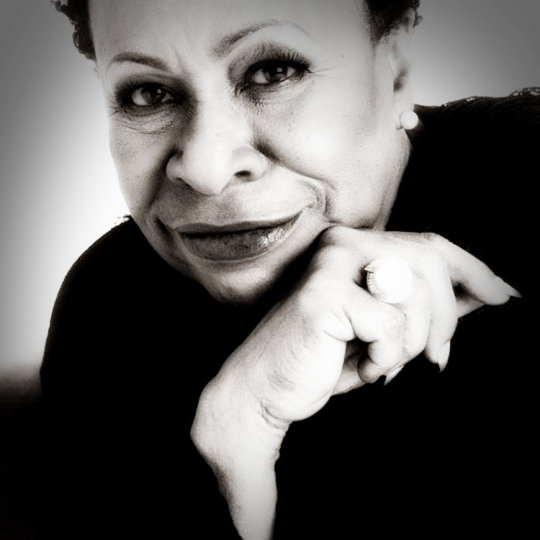


Betty Carter (born Lillie Mae Jones; May 16, 1929 – September 26, 1998) was an American jazz singer known for her improvisational technique, scatting and other complex musical abilities that demonstrated her vocal talent and imaginative interpretation of lyrics and melodies. Vocalist Carmen McRae once remarked, "There's really only one jazz singer—only one: Betty Carter."
Early life
Carter was born in Flint, Michigan, and grew up in Detroit, where her father, James Jones, was the musical director of a Detroit church and her mother, Bessie, was a housewife. As a child, Carter was raised to be extremely independent and to not expect nurturing from her family. Even thirty years after leaving home, Carter was still very aware of and affected by the home life she was raised in, and was quoted saying:
"I have been far removed from my immediate family. There's been no real contact or phone calls home every week to find out how everybody is…As far as family is concerned, it's been a lonesome trek…It's probably just as much my fault as it is theirs, and I can't blame anybody for it. But there was…no real closeness, where the family urged me on, or said…'We're proud'…and all that. No, no…none of that happened."
Despite the isolation from her family that Carter felt due to their lack of support, it is possible to attribute her fighting spirit and determination to make it in the music business to this sense of abandonment, leading her to be the legend that she is today. She studied piano at the Detroit Conservatory at the age of fifteen, but did not exceed a modest level of expertise.
At the age of sixteen, Carter began singing. As her parents were not big proponents of her pursuing a singing career, Carter would sneak out at night to audition for amateur shows. After winning first place at her first amateur competition, Carter felt as though she were being accepted into the music world and decided that she must pursue it tirelessly. When Carter began performing live, she was too young to be admitted into bars, so she obtained a forged birth certificate to gain entry in order to perform.
Career
Even at a young age, Carter was able to bring a new vocal style to jazz. The breathiness of her voice was a characteristic seldom heard before her appearance on the music scene. She also was well known for her passion for scat singing and her strong belief that the throwaway attitude that most jazz musicians approached it with was inappropriate and wasteful due to its spontaneity and basic inventiveness, seldom seen elsewhere.
Detroit, where Carter grew up, was a hotbed of jazz growth. After signing with a talent agent after her win at amateur night, Carter had opportunities to perform with famous jazz artists such as Dizzy Gillespie, who visited Detroit for an extensive amount of time. Gillespie is often considered responsible for her strong passion for scatting. In earlier recordings, it is apparent that her scatting had similarities to the qualities of Gillespie's.
At the time of Gillespie's visit, Charlie Parker was receiving treatment in a psychiatric hospital, delaying her encounter with him. However, Carter eventually also received an opportunity to perform with Parker, as well as with his band consisting of Tommy Potter, Max Roach, and Miles Davis. After receiving praise from both Gillespie and Parker for her vocal prowess, Carter felt a strong burst in confidence and knew that she could make it in the business with perseverance.
Carter was right. In 1948, Carter was asked by Lionel Hampton to join his band. Carter finally had her big break. Working with Hampton's group gave her the chance to be band mates with artists such as Charles Mingus and Wes Montgomery as well as with Ernest Harold "Benny" Bailey, who had recently vacated Gillespie's band and Albert Thornton "Al" Grey who would later go on to join Gillespie's band. Hampton obviously had an ear for talent and a love for bebop. Carter too had a deep love for bebop as well as a talent for it. Hampton's wife Gladys gave her the nickname "Betty Bebop", a nickname she reportedly detested. Despite her good ear and charming personality, Carter was fiercely independent and had a tendency to attempt to resist Hampton's direction, while Hampton had a temper and was quick to anger. Hampton expected a lot from his players and did not want them to forget that he was the band's leader. She openly hated his swing style, refused to sing in a swinging way, and she was far too outspoken for his tastes. Carter honed her scat singing ability while on tour, which was not well received by Hampton as he did not enjoy her penchant for improvisation. Over the course of two and a half years, Hampton fired Carter a total of seven times.
Being a part of Hampton's band provided a few things for "The Kid" (a nickname bestowed upon Carter that stuck for the rest of her life): connections, and a new approach to music, making it so that all future musical attitudes that came from Carter bore the mark of Hampton's guidance. Because of Hampton's hiring of Carter, she also goes down in history as one of the last big band era jazz singers in history. However, by 1951, Carter left the band. After a short recuperation back home, Carter was in New York, working all over the city for the better part of the early 1950s, as well as participating in an extensive tour of the south, playing for "camp shows". This work made little to no money, but Carter believed it was necessary in order to develop as an artist, and was a way to "pay her dues".
Very soon after Carter's arrival in New York City, she was given the opportunity to record with King Pleasure and the Ray Bryant Trio, becoming more recognizable and well known and subsequently being granted the chance to sing at the Apollo Theatre. This theatre was notorious for giving up-and-coming artists the final shove into becoming household names. Carter was propelled into notoriety, recording with Epic label by 1955 and was a well-known artist by the late 1950s. Her first solo LP, Out There, was released on the Peacock label in 1958.
Miles Davis can be credited for Carter's bump in popularity, as he was the person who recommended to Ray Charles that he take Carter under his wing. Carter began touring with Charles in 1960, then making a recording of duets with him in 1961, including the R&B-chart-topping "Baby, It's Cold Outside," which brought her a measure of popular recognition. In 1963 she toured in Japan with Sonny Rollins. She recorded for various labels during this period, including ABC-Paramount, Atco and United Artists, but was rarely satisfied with the resulting product. After three years of touring with Charles and a total of two recordings together, Carter took a hiatus from recording to marry. She and her husband had two children. However, she continued performing, not wanting to be dependent upon her husband for financial support.
The 1960s became an increasingly difficult time for Carter as she began to slip in fame, refusing to sing contemporary pop music, and her youth fading. Carter was nearly forty years old, which at the time was not conducive to a career in the public eye. Rock and Roll, like pop, was steadily becoming more popular and provided cash flow for labels and recording companies. Carter had to work extremely hard to continue to book gigs because of the jazz decline. Her marriage also was beginning to crumble. By 1971, Carter was single and mainly performing live with a small group consisting of merely a piano, drums, and a bass. The Betty Carter trio was one of very few jazz groups to continue to book gigs in the late 1960s and early 1970s.
Carter created her own record label, Bet-Car Records, in 1969, the sole recording source of Carter's music for the next eighteen years:
....in fact, I think I was probably the first independent label out there in '69. People thought I was crazy when I did it. 'How are you gonna get any distribution?' I mean, 'How are you gonna take care of business and do that yourself?' 'Don't you need somebody else?' I said, 'Listen. Nobody was comin' this way and I wanted the records out there, so I found out that I could do it myself.' So, that's what I did. It's the best thing that ever happened to me. You know. We're talking about '69!
Some of her most famous recordings were originally issued on Bet-Car, including the double album The Audience with Betty Carter (1980). In 1980 she was the subject of a documentary film by Michelle Parkerson, But Then, She's Betty Carter. Carter's approach to music did not concern solely her method of recording and distribution, but also her choice in venues. Carter began performing at colleges and universities, starting in 1972 at Goddard College in Vermont. Carter was excited at this opportunity, as it was since the mid-1960s that Carter had been wanting to visit schools and provide some sort of education for students. She began lecturing along with her musical performances, informing students of the history of jazz and its roots.
By 1975, Carter's life and work prospects began to improve, and Carter was beginning to be able to pick her own jobs once again, touring in Europe, South America, and the United States. In 1976, Carter was a guest live performer on Saturday Night Live′s first season on the air, and was also a performer at the Newport Jazz Festival in 1977 and 1978, carving out a permanent place for herself in the music business as well as in the world of jazz.
In 1977, Carter reached a new high in fame for herself, being lauded by critics, media, and fans for her talent, and even teaching a master class with her past mentor, Dizzy Gillespie, at Harvard. In the last decade of her life, Carter began to receive even wider acclaim and recognition. In 1987 she signed with Verve Records, who reissued most of her Bet-Car albums on CD for the first time and made them available to wider audiences. In 1988 she won a Grammy for her album Look What I Got! and sang in a guest appearance on The Cosby Show (episode "How Do You Get to Carnegie Hall?"). In 1994 she performed at the White House and was a headliner at Verve's 50th anniversary celebration in Carnegie Hall. She was the subject of a 1994 short film by Dick Fontaine, Betty Carter: New All the Time.
In 1997 she was awarded a National Medal of Arts by President Bill Clinton. This award was one of thousands, but Carter considered this medal to be her most important that she received in her lifetime.
Death
Carter continued to perform, tour, and record, as well as search for new talent until she was diagnosed with pancreatic cancer in the summer of 1998. She died on September 26, 1998, at the age of 69, and was later cremated. She was survived by her two sons.
Legacy
Carter often recruited young accompanists for performances and recordings, insisting that she "learned a lot from these young players, because they're raw and they come up with things that I would never think about doing."
1993 was Carter's biggest year of innovation, creating a program called Jazz Ahead, which took 20 students who were given the opportunity to spend an entire week training and composing with Carter, a program that still exists to this day and is hosted in The Kennedy Center.
Betty Carter is considered responsible for discovering great jazz talent, her list including such names as John Hicks, Curtis Lundy, Mulgrew Miller, Cyrus Chestnut, Dave Holland, Stephen Scott, Kenny Washington, Benny Green and more.
Miscellaneous
Carter is mentioned along with other jazz luminaries in Gang Starr's jazz rap "Jazz Thing."
In 1999 she was posthumously inducted into the Down Beat Jazz Hall of Fame.
She is name-checked in Chapter 22 of Saul Williams's The Dead Emcee Scrolls.
Discography
Compilations
1990 Compact Jazz – Polygram – Bet-Car and Verve recordings from 1976 to 1987
1992 I Can't Help It – Impulse!/GRP – the Out There and Modern Sound albums on one compact disc
1999 Priceless Jazz – Verve – ABC-Paramount and Peacock Recordings from 1958 and 1960
2003 Betty Carter's Finest Hour – Verve – recordings from 1958 to 1992
On multi-artist compilations
"I'm Wishing" on Stay Awake: Various Interpretations of Music from Vintage Disney Films (1988).
"Lonely House" on September Songs - The Music of Kurt Weill (1997).
Wikipedia
3 notes
·
View notes